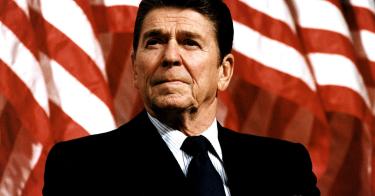There’s widespread dissatisfaction with the economy today among Americans, and no wonder: Prices are rising faster than earnings, and living standards have declined. But America has sailed into this economic storm before, and our predecessors left us a guide for navigating these troubled waters.
The last time the U.S. had inflation this high and economic growth this low was over 40 years ago. That malaise was created by the same deadly cocktail that has caused our current troubles: government overspending, overtaxing, and overregulating.
By the late 1970s, the leviathan of the federal government had imposed a top income tax rate of 70%. Spending, meanwhile, was higher than ever. Regulation was strangling the economy, particularly the energy sector.
Since government spending far exceeded the Treasury’s ability to borrow, the Federal Reserve created money to finance the runaway deficits of that era. Thus, the government effectively collected revenue not only through explicit, sky-high taxes like federal income tax but also through the hidden tax of inflation.
>>> Wrecking the American Dream: The Problem With Today’s Economy
The government confiscated so many proceeds from individuals’ labor, drastically reducing incentives to work and invest. Burdensome and ineffective regulations further added costs without adding any reward.
Year after year, prices rose faster than wages, necessities such as housing became increasingly unaffordable, and living standards declined. The family budget shrunk as the federal budget grew.
Some people gave up hope of ever returning to rapid economic growth, confining the nation’s destiny to perpetual mediocrity. The ideas—and ideals—of American exceptionalism, entrepreneurship and rugged individualism no longer applied.
That changed when President Ronald Reagan preached a hopeful gospel to a depressed nation. His creed included lower taxes and spending wherever possible, along with less onerous regulation. Reagan prophesied that this would resurrect the economy and Americans’ standard of living.
He famously said the government was not the solution but the cause of America’s problems. Reagan was able to shepherd significant tax reform through Congress, including reducing the top tax rate by more than one-quarter. His administration also went on a deregulation crusade to prevent government bureaucrats from meddling in Americans’ lives.
The result was a tremendous increase in people’s incentives to work, invest, invent and increase wealth because they could keep more of the proceeds of their labor.
As for the Federal Reserve, the central bank rolled back its policy of financing budget deficits and manipulating interest rates. The painful return to the normalcy of monetary policy was a chemotherapy and radiation treatment with the painful side effect of back-to-back recessions, but which ultimately excised the cancerous inflation from the American economy.
Reagan’s predecessors in both political parties implemented policies that directly and indirectly punished thrift, innovation, industriousness and wealth accumulation. Reagan promised to reverse the anemic economic growth and high inflation spawned by years of failed public policy.
>>> Your Money Problems Are Imaginary, the White House Claims. The Facts Say Otherwise.
As was the case 40 years ago, today’s economic wounds are self-inflicted. The upside to this malady is that we too can reverse the negative outcomes by simply reversing the negative public policies that created them.
The Biden administration’s regulatory war on business, particularly energy, must be ended if economic recovery is ever to reach middle America. Similarly, the big spenders in Congress—Democrats and Republicans alike—must be stopped before they spend the nation into the ground.
The federal debt is almost $35 trillion, and the interest payments alone exceed 40% of all personal income taxes. If government spending is not radically reduced, even more confiscatory taxes will be needed just to service the debt without ever paying it down. That would truly destroy the incentives to work and invest.
Reducing spending is especially imperative for the Fed to fight inflation. Absent spending reform, the central bank will continue letting inflation run rampant to finance multitrillion-dollar budget deficits. Take away the profligate spending, and the Fed’s greatest incentive to cause inflation vanishes.
If these changes seem impossible today, recall that Reagan’s agenda likewise seemed improbable in 1980. In the spirit of his eternal optimism, America should remain hopeful that there is still a chance—though perhaps only a last chance—to turn things around.
This piece originally appeared in The Washington Times





